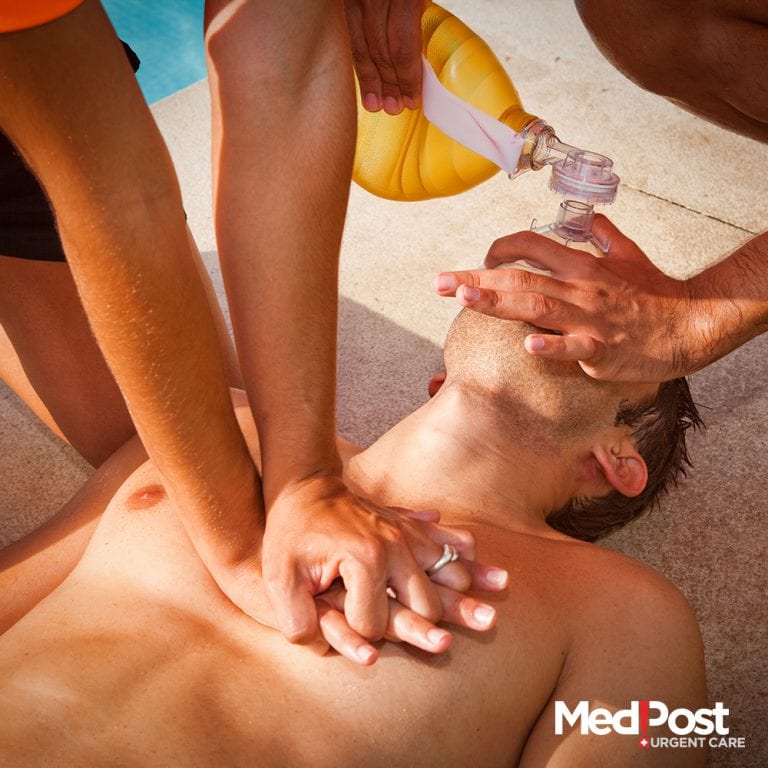From CPR to the Heimlich: 5 life-saving skills that everyone should know
August 24, 2015

Emergencies are called emergencies for a reason, but don’t be caught off guard if a situation arises that requires medical attention.
There are various certifications and training seminars that can help your family best prepare for the unpredictable.
CPR
The most recognized lifesaving maneuver is cardiopulmonary resuscitation (CPR), a technique utilized in various emergencies including heart attack, cardiac arrest, and drowning. According to the American Heart Association, only 32 percent of cardiac arrest victims receive CPR from a bystander. Statistically speaking, since 4 out of 5 cardiac arrests occur at home, CPR could potentially save the life of a family member or friend.
If a CPR-related emergency occurs and the victim is unconscious, have someone immediately call 911 while you perform CPR. If you or other bystanders are untrained in proper CPR delivery, the American Heart Association recommends giving the victim continuous hands only chest compressions, totaling around 100 compressions a minute until the paramedics arrive or there are signs of movement. In adult victims, hands only chest compressions should be hard enough to move the chest inward about 1.5 to 2 inches.
While performing hands-only or trained CPR, remember the acronym, CAB –compression, airway, and breathing. Prepare for a CPR emergency by watching a professional instructional video or enrolling in a CPR training course.
Heimlich Maneuver
Some medical emergencies are the fault of a poor genetic disposition or unhealthy lifestyle, but choking is the result of an obstructed windpipe blocked by food or other objects. Like any other emergency, understanding the signs of choking is vital for a higher survival rate. Without oxygen, a choking victim is susceptible to brain damage in 4 to 6 minutes.
If a person begins choking, but they can still talk, do not perform the Heimlich maneuver because intense coughing may be enough to dislodge the object from the throat. However, if the choking victim is conscious but cannot talk, have someone call 911 and begin abdominal thrusts or for the less trained bystander, perform back blows. If efforts to perform the Heimlich maneuver are ineffective and the victim becomes unconscious, begin CPR until medical professionals arrive.
Escaping a Fire From a Burning Building
Beginning in preschool, children are taught how to protect themselves from fires and earthquakes and it’s no wonder why. Although industrial and public buildings should have adequate sprinkler systems and fire alarms, unpredictable fires can occur at any time. In order to protect yourself from a fire, you must first understand what ignites and feeds the fire. Fires and people compete for oxygen to sustain life, however a lack of oxygen in humans causes loss of coordination, stamina, or death.
In case of emergency, prepare both a primary and alternative route for exiting a burning building. The noxious cloud of gases caused by a fire rise to the ceiling of a building, so crawl to the safest exit with a wet cloth wrapped around your nose and mouth. If you are exiting through a window, smash the bottom corner of the pane with a hard object and cushion the broken window with a blanket or pillow for a safe exit. If you are exiting through a closed door, use the back of your hand to feel the door, the knob and it’s hinges. If these areas of the door are cool to the touch, brace your shoulder against the door and slowly open it to avoid a surge of pressure bounding the door open.
Save Someone From Drowning
According to the Center for Disease Control and Prevention, drowning is globally the third leading cause of unintentional injury. If an active drowning occurs while a lifeguard is on duty, notify the nearest lifeguard. If a trained professional is not on duty, call 911. When a person is drowning, they might not have enough oxygen to shout for help, so be cognizant of a victim’s flailing arms and submerging head.
Larger bodies of water require more training and knowledge of lifesaving procedures because they have harsher conditions, such as stronger currents and farther distances. For basic drowning rescue, first assess if a person is actually drowning. If the drowning victim is too far to reach by throwing a ring buoy or shepherd’s crook, swim freestyle out to them with a flotation device and a towel or t-shirt to tow them in.
Maintain a safe distance from the victim because they may accidentally bring you underwater while trying to stay afloat. If this happens, remain calm and pull away by submerging yourself underwater until the victim releases you. Shout at the victim to grab the flotation device and once attached, safely move in a straight line back to shore. If the victim is not breathing, check their vitals for 10 seconds before initiating CPR until help arrives.
How to Use an AED
An automated external defibrillator is a medical device used to treat victims of sudden cardiac arrest. Most public buildings such as schools or malls have an AED available for use. In fact, if proper defibrillation is performed within three minutes of sudden cardiac arrest, a victim’s chance of survival increases 70 percent.
Before proceeding with an AED, check the victim to determine if they are unconscious. If so, call 911 or have another bystander do so while you perform defibrillation.
When initiating the usage of an AED, move the victim to a dry area, completely dry the victim’s chest, and remove all metal objects from the body. Begin by powering the AED, and follow the step-by-step voice instructions and prompt until paramedics arrive.
If there are other bystanders present while an emergency is occurring, have someone else call 911 while you prepare to help a victim. Remember to stay as calm as possible in any emergency situation. For more information on emergency lifesaving procedures, please visit an urgent care near you.
